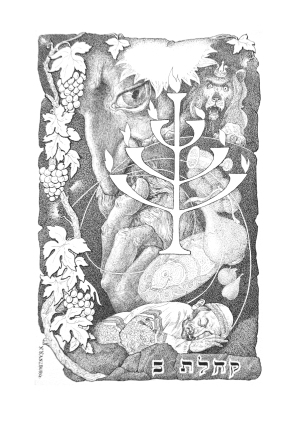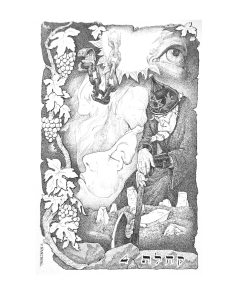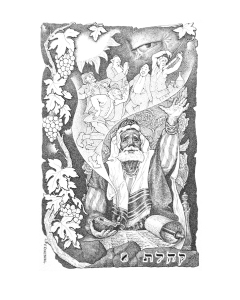Gennady Mesh, editor of the web magazine “Russian Globe” reviews new works by Yury Kanzburg.
“All of man’s toil is for the sake of his mouth, yet his soul is never satisfied” – says Ecclesiastes. – “All is vanity” and only the spiritual way can result in something.
Art is similar to religion, every day, creates and changes the world. The heart of the artist has experienced this huge theme and there are magnificent drawings.
The first time I became acquainted with the works of the artist Yury Kanzburg in August 2010 at an exhibition at the Russian community in Chicago. I was immersed in landscapes and a number of works, especially a portrait of his wife, Mira. The picture seemed to thaw in the face of, exhaled warmth, light – the master’s, only, perfectly knowing, infinitely loving nature could enclose so great feelings.
Now there is a new series of works, however, in its graphic illustrations, they are very difficult to identify in any genre. There are no plots, characters, concrete events. There is a sight of the wise person at life, at people, events, the person whose heart has learned all parties of life. The artist reveals by drawing deep reflections – about life, death, destiny and appointment of the person, his communication with the Creator. Together with the author of “Ecclesiastes” (in Hebrew – Kohelet, the Preacher) the artist argues on the same, only by means of artistic images, graphically executing by pen and ink in strokes, points and lines, accurately preserves the tone-severity and unity of style.
Varying only one color, black, on a rough impressive paper, the Master creates a huge variety of color shades, dimensions and depth of represented subjects. His black color is tragically strained, at the same time is simple, deep and solemn. Wise and correct, not giving in to other estimation. Color acts as a criterion of logic correctness and unambiguity of all narration, perfectly accompanying the short, compressed phrases of Kohelet.
All the drawings are united by structural elements: it is the grapevine growing on stones, on the earth of Israel – a symbol of immortality of the Jewish people; it is G-d’s providence, how G-d looks at the life of His people; it is a stone on which drawings are put. At all drawings constantly there is an eye, steadfast, with sympathy observes that occurs – rejoices, fears, warns…
Each of the twelve filigree-executed works corresponds to one of the chapters of Kohelet, which are also twelve, and are accompanied by citations there from, taken as a principle for the Master’s art plan.
Kohelet – one of the most sophisticated religious-philosophical works entering into the Tanakh (The Hebrew Holy scripts). Its author is believed to be the King of Jerusalem, Solomon. The work has a deep depth, like any serious work, a set of treatments.
For human history, the large quantity of artworks illustrating the Bible is created. They are devoted to some or other characters, and scenes, however, don’t have any (at least known to me), who would reflect philosophy of reasoning of this script, as well as to other works of the Bible; no one which is done by means of realistic art. As religious work, is deeply intimate. Everyone looking at it will find a special understanding and personal relation to it, not only to the script, but also to its illustrations.
Sixteen years of reflections were needed for Yury Kanzburg to plan the work and about six month to execute it. Subconscious preparation for an illustration of Kohelet began in the former Soviet Union, in Ukraine, where the artist lived and worked.
Conditions of interdictions for communication of Jews with their religion and culture, and even more – impossibility to feel equal among equals on the earth, where they were born, to which gave their talent, pushed to creative reflection and imagination which nobody could take away from them.
 In artistic companions, Yury Kanzburg is close to the world-famous illustrator of the Bible Gustave Dore, in the movement of philosophical thought to etchings of the great Goya. He carries his own handwriting in the technique of execution of drawing and in its plotless basis that perfectly transfers a metaphysical vision of the world. This vision consists of a constant, never-ending role of the Jewish people, transferring to humankind G-d’s sight of the world through the spirit, perception and the morals granted them by the Creator.
In artistic companions, Yury Kanzburg is close to the world-famous illustrator of the Bible Gustave Dore, in the movement of philosophical thought to etchings of the great Goya. He carries his own handwriting in the technique of execution of drawing and in its plotless basis that perfectly transfers a metaphysical vision of the world. This vision consists of a constant, never-ending role of the Jewish people, transferring to humankind G-d’s sight of the world through the spirit, perception and the morals granted them by the Creator.
In it, the reproach of avidity and nonsense, senselessness of all terrestrial accumulation, condemnation of cruelty, tyranny, an appeal to work, pleasures, to mercy, necessity of constant movement of Jews to the Temple, sounds very clearly.
Playing along, contradictions in real life, creates a bent to an inevitable moral choice. The conclusion also arises: if each person is mortal, if the poor man and the rich man invariably appear before G-d, is it better to live life justly, without burdening oneself with the weight of sins?
It is possible to argue on each of the drawings indefinitely, for they are a prototype of the reflections expressed in the wise sayings by Kohelet. The artist has given them in a high composite saturation and balance of all details of drawing. From here without exaggeration, it is possible to say – it is an ode, a hymn, a requiem of human life, a harmonious vision of its launches and fallings.
In his own country, despite a set of most interesting works made during long years of creative activity, Yury Kanzburg was not accepted in the Union of Artist. Arrival in America has opened a late, but new page of his talent. It has given him the chance to plunge into the atmosphere of religion and culture, to remove a taboo of prohibition, finally to create a remarkable series of works, which I, am sure, will enter into the treasury of national and world culture.



